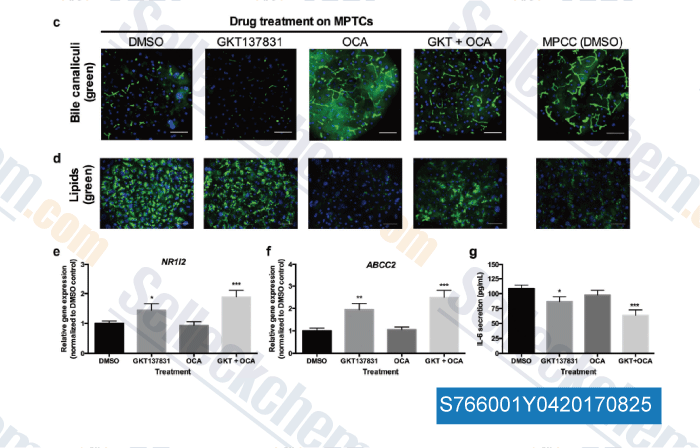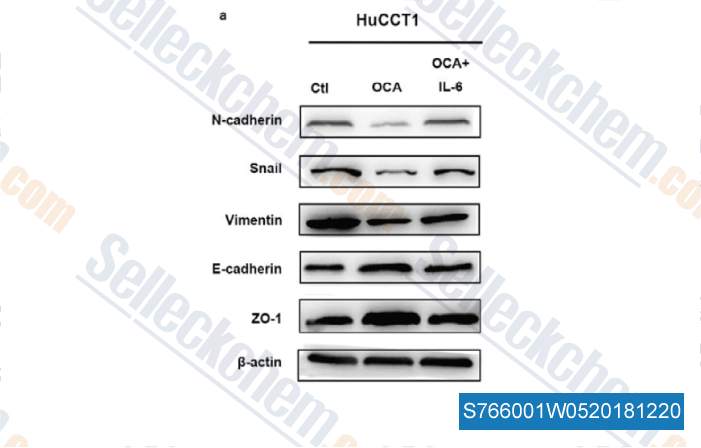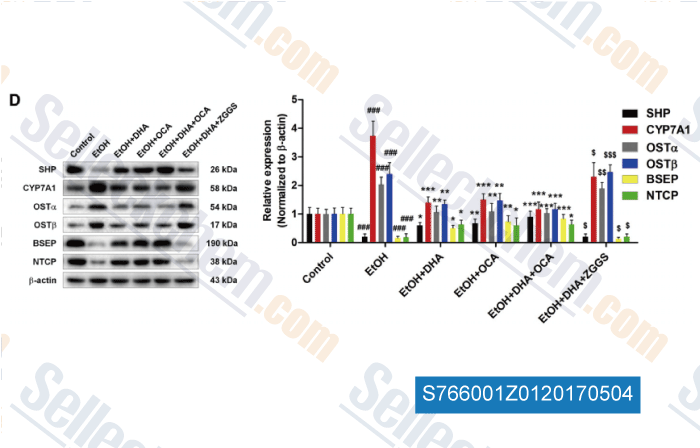|
Toll Free: (877) 796-6397 -- USA and Canada only -- |
Fax: +1-832-582-8590 Orders: +1-832-582-8158 |
Tech Support: +1-832-582-8158 Ext:3 Please provide your Order Number in the email. |
Technical Data
| Formula | C26H44O4 |
||||||||||
| Molecular Weight | 420.63 | CAS No. | 459789-99-2 | ||||||||
| Solubility (25°C)* | In vitro | DMSO | 84 mg/mL (199.7 mM) | ||||||||
| Ethanol | 84 mg/mL (199.7 mM) | ||||||||||
| Water | Insoluble | ||||||||||
| In vivo (Add solvents to the product individually and in order) |
|
||||||||||
|
* <1 mg/ml means slightly soluble or insoluble. * Please note that Selleck tests the solubility of all compounds in-house, and the actual solubility may differ slightly from published values. This is normal and is due to slight batch-to-batch variations. * Room temperature shipping (Stability testing shows this product can be shipped without any cooling measures.) |
|||||||||||
Preparing Stock Solutions
Biological Activity
| Description | Obeticholic Acid (INT-747) is a potent and selective farnesoid X receptor (FXR) agonist with EC50 of 99 nM. Obeticholic Acid inhibits autophagy. Phase 3. | ||
|---|---|---|---|
| Targets |
|
||
| In vitro | In HuH7 cells, Obeticholic Acid acts as a potent FXR agonist with EC50 of 85 nM. [1] |
||
| In vivo | In rat cholestasis model, Obeticholic Acid promotes bile flow, and protects hepatocytes against acute necrosis caused by LCA. [1] Obeticholic Acid (p.o.) improves proteinuria, ameliorates renal structural changes, and modulates renal inflammation and oxidative stress in WD-fed DBA mice. [2] In thioacetamide (TAA)-intoxicated and bile-duct-ligated (BDL) rats, Obeticholic Acid (30 mg/kg p.o.) reactivates the FXR downstream signaling pathway and decreases portal pressure by lowering total IHVR without deleterious systemic hypotension. [3] |
Protocol (from reference)
| Kinase Assay: |
|
|---|---|
| Animal Study: |
|
References
|
Customer Product Validation

-
, , Integr Biol (Camb), 2017, 9(8):662-677

-
Data from [Data independently produced by , , Cell Physiol Biochem, 2018, 48(1):158-172]

-
Data from [Data independently produced by , , Toxicol Appl Pharmacol, 2017, 315:23-34]
Selleck's Obeticholic Acid (INT-747) has been cited by 19 publications
| FXR controls duodenogastric reflux-induced gastric inflammation through negatively regulating ER stress-associated TNXIP/NLPR3 inflammasome [ iScience, 2024, 27(3):109118] | PubMed: 38439955 |
| Tetrahydropalmatine ameliorates hepatic steatosis in nonalcoholic fatty liver disease by switching lipid metabolism via AMPK-SREBP-1c-Sirt1 signaling axis [ Phytomedicine, 2023, 119:155005] | PubMed: 37562090 |
| Ursodeoxycholic acid reduces antitumor immunosuppression by inducing CHIP-mediated TGF-β degradation [ Nat Commun, 2022, 13(1):3419] | PubMed: 35701426 |
| Systemic ASBT inactivation protects against liver damage in obstructive cholestasis in mice [ JHEP Rep, 2022, 4-11:100573] | PubMed: 36160754 |
| A Quantitative Systems Pharmacology Platform Reveals NAFLD Pathophysiological States and Targeting Strategies [ Metabolites, 2022, 12(6)528] | PubMed: 35736460 |
| A Quantitative Systems Pharmacology Platform Reveals NAFLD Pathophysiological States and Targeting Strategies [ Metabolites, 2022, 10.3390/metabo12060528] | PubMed: 35736460 |
| Obeticholic Acid Inhibits Anxiety via Alleviating Gut Microbiota-Mediated Microglia Accumulation in the Brain of High-Fat High-Sugar Diet Mice [ Nutrients, 2021, 13(3)940] | PubMed: 33803974 |
| Resolution of NASH and Hepatic Fibrosis by the GLP-1R/GcgR Dual-Agonist Cotadutide via Modulating Mitochondrial Function and Lipogenesis [ Nat Metab, 2020, 2(5):413-431] | PubMed: 32478287 |
| Stimulation of soluble guanylate cyclase exerts antiinflammatory actions in the liver through a VASP/NF-κB/NLRP3 inflammasome circuit [ Proc Natl Acad Sci U S A, 2020, 117(45):28263-28274] | PubMed: 33106416 |
| FXR Regulates Intestinal Cancer Stem Cell Proliferation [Fu T, et al Cell, 2019, 176(5):1098-1112] | PubMed: 30794774 |
RETURN POLICY
Selleck Chemical’s Unconditional Return Policy ensures a smooth online shopping experience for our customers. If you are in any way unsatisfied with your purchase, you may return any item(s) within 7 days of receiving it. In the event of product quality issues, either protocol related or product related problems, you may return any item(s) within 365 days from the original purchase date. Please follow the instructions below when returning products.
SHIPPING AND STORAGE
Selleck products are transported at room temperature. If you receive the product at room temperature, please rest assured, the Selleck Quality Inspection Department has conducted experiments to verify that the normal temperature placement of one month will not affect the biological activity of powder products. After collecting, please store the product according to the requirements described in the datasheet. Most Selleck products are stable under the recommended conditions.
NOT FOR HUMAN, VETERINARY DIAGNOSTIC OR THERAPEUTIC USE.
